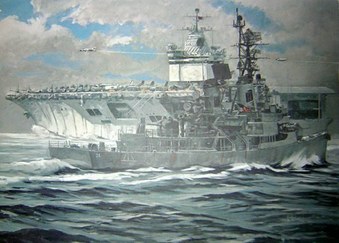
1
COMING INTO THE WIND by John Charles Roach
Depicts the U.S.S. Waddell DDG-24, a United States Naval Guided Missile Destroyer, which is alongside the Aircraft Carrier USS Enterprise CVN-65
| 
2
| 
3
Homecoming of Destroyer Squadron 24
from Vietnam 4/6/66 Newport, Rhode Island
Painting #17 Joe De Thomas (NACAL) Artist
| 
4
| 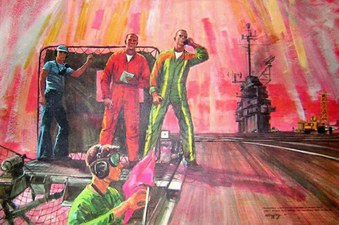
5
Pensacola LSO’s Lt. Jim Ford and Lt. Dennis Price
Direct Student Pilot Aboard USS Lexington, Gulf of Mexico
McCaffrey '64
| 
6
| 
7
SAFETY LINE by John Charles Roach
| 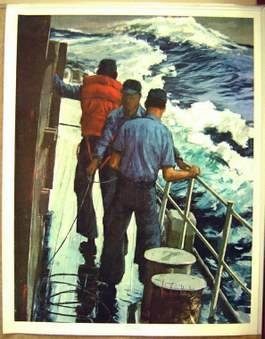
8
| 
9
RIALTO, AT PORTO BEL GRANO by Keith Bruce Finch
| 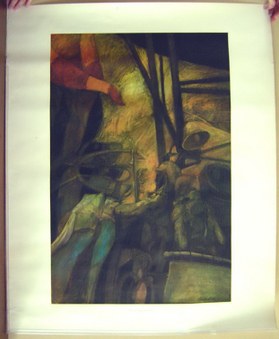
10
| 
11
HOME PORT by John S. Cipot
Depicts USS Nimitz in its home port of Norfolk, Virginia between May and June 1975
| 
12
| 
13
Original 1980 U.S. Armed Forces Recruitment Poster
| 
14
| 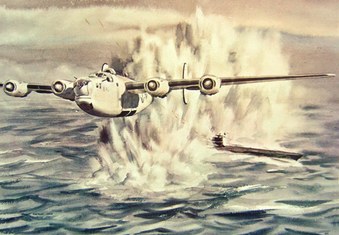
15
"MAY THIS INAUGURATE A GREAT HUNTING SEASON." Admiral Harold Stark
A Kill In Biscay
During World War II, patrolling the Bay of Biscay was the responsibility of the Coastal Command of the Royal Air Force. Attached to this command was the U.S. Navy's Fleet Air Wing Seven whose pilots flew PB4Y's, the Navy version of the Army's B-24 Liberator. Out of the gray mist of Biscay, A PB4Y is seen strafing a Nazi submarine on the surface while laying a stick of depth bombs athwart her. The big bomber ideally approached the target at 50 feet, strafed it with the bow turret guns while releasing the bomb load and then the tail gunner fired at the conning tower with tracers as the aircraft completed its attack. This antisubmarine warfare offensive helped raise the score of enemy submarines sunk in July 1943 to a record high of 45.
WATERCOLOR BY DWIGHT SHPLER, U.S. Navy Combat Art Collection
| 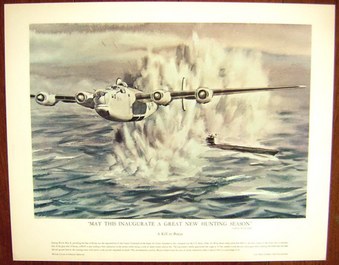
16
| 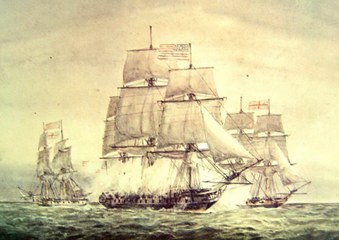
17
"IF THE SHIP CANNOT BE FOUGHT WITHOUT ME, I WILL BE BROUGHT ON DECK." Captain John Barry
ALLIANCE Captures ATLANTA and TREPASSY, 29 May 1781
Captain John Barry, in the frigate ALLIANCE, was returning from France, when, off the coast of Nova Scotia, he sighted two sails; one, the British sloop ATLANTA, 16 guns; the other, the British brig TREPASSY, 14 guns. A very light wind prevented ALLIANCE from maneuvering into favorable position. The smaller British ships were able to maintain a ranking position by means of sweeps (large oars). For 4 hours ALLIANCE was subjected to a grueling fire, replying occasionally with only a bow or stern gun. Wounded in the shoulder by grape shot, Barry courageously remained in command on deck until forced below by loss of blood. Suddenly a breeze sprang up, ALLIANCE, came to life, fired several broadsides causing the two British vessels to strike their colors.
WATER COLOR BY CHARLES TURNER WARREN, The Mariners Museum
| 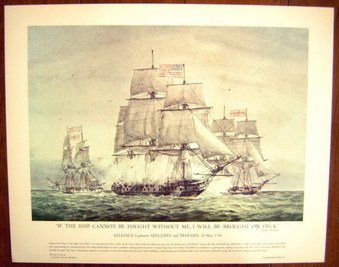
18
| 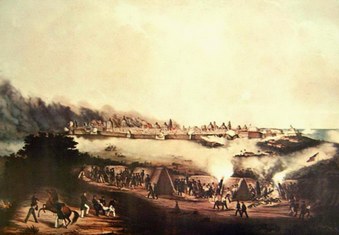
19
"CERTAINLY, GENERAL, BUT I MUST FIGHT THEM." Commodore Matthew C. Perry
The U.S. Naval Battery During the Bombardment of Vera Cruz on 24 and 25 March 1847
On March 9, 1847, the Navy landed over 10,000 troops with supplies just below Vera Cruz under the cover of Commander Josiah Tattnall's gunboats. Some 12 days later, lacking heavy ordnance, General Winfield Scott requested naval guns be landed to breach the walls of the city. Commodore M. C. Perry replied, "Certainly, General, but I must fight them." Supported by the gunboats, and light Army ordnance, the large cannon manned by bluejackets began their steady bombardment on March 24. On the following day, after naval battery has badly breeched the city's walls, the enemy ceased firing and opened negotiations under a flag to truce. Vera Cruz surrendered on March 29th.
COLOR LITHOGRAPH AFTER A PAINTING BY H. WALKE, Department of the Navy
| 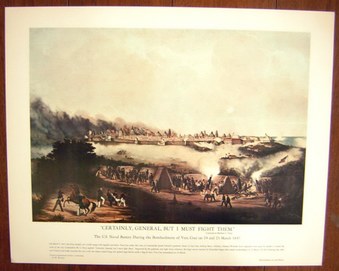
20
| 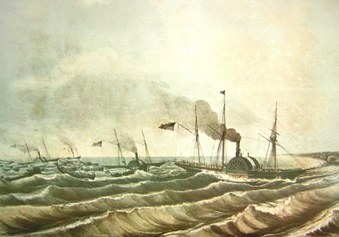
21
"I WAS STRUCK AS I OFTEN BEEN BEFORE WITH THE UNIVERSAL ENTHUSIASM EXHIBITED BY THE OFFICERS AND MEN." Commodore Matthew C. Perry
The U.S. Steamers SCORPION, SPITFIRE, VIXEN and SCOURAGE With 40 Barges in Tow, Crossing the bar at the Mouth of the Tabasco River, Mexico, 14 June 1847
After the fall of Vera Cruz, Commodore Matthew C. Perry led an expeditionary force of 1,000 marines and seamen against enemy positions on the Tabasco River. Perry crossed the bar at the mouth of the river on 14 June and occupied Frontera without opposition. Pressing on to attack San Juan Bautista which lay 60 miles up the river, an obstruction caused Perry to land his force 9 miles below the town. Meanwhile, the side-wheel steamers bombarded and passed the obstruction, covering Perry's river flank as he marched on the city. This operation was the last amphibious assault of the Gulf Squadron.
COLOR LITHOGRAPH OF A DESIGN DRAWN ON STONE BY H. WALKE, Department of the Navy
| 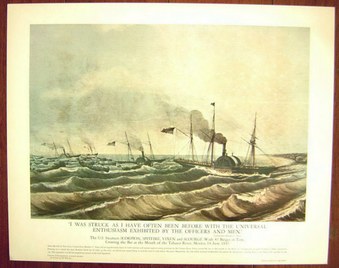
22
| 
23
Alliance vs Sybil
10 March 1783
This was the last naval battle of the Revolutionary War. Continental frigate Alliance (Captain John Barry) in company with Duc de Lauzun departed Havana carrying a large sum of money for Congress. South of Cape Canaveral, Florida, the Americans sighted three enemy warships closing rapidly. To allow his dull-sailing companion time to jettison cannon and escape, Barry placed Alliance between onrushing HMS Sybil and the plodding Duc de Lauzun. Shot from the British frigate's bow guns crashed into Alliance, but Captain Barry held his gunners in check until the proper moment. Shortly before noon, the ships came abreast, and Sybil, considerably damaged in sails and rigging, sheered off to rejoin her consorts which had rendered no support the the action with Alliance.
Naval History Division, Department of the Navy, Washington D.C.
| 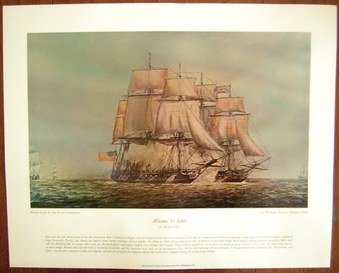
24
| 
25
"SO EFFECTIVE HAS BEEN THE PERFORMANCE OF THE DUTY OF THE NAVY IN EVERY QUARTER OF THE GLOBE, THAT OUR INCREASING COMMERCE IN THE MOST DISTANT SEAS HAS FELT NO CHECK AND MET NO INTERUPTION." Secretary of the Navy John Y. Mason
The Landing Force Departs on an Expedition at Loreto, 5 October 1847
The naval conquest of California was consummated more than a year before the war with Mexico could be concluded in the east. While fighting in eastern Mexico continued, the Navy on the west coast was consolidating its position in California. In part this was done by tightening the blockade and by attacking the principal seaports along the west coast. DALE was ordered to "run along the coast to look out for privateers and merchant vessels of the enemy." Her operations were of direct help to General Winfield Scott in the east. The ship's Gunner, William H. Meyers, drew several watercolor sketches of DALE during this voyage. In this exampl...
| 
26
| 
27
"A NEW ERA SEEMS, THROUGH THEIR INSTRUMENTALITY, TO BE DAWNING UPON THE COMMERCE OF THE WORLD." Secretary of the Navy J. B. Dobbin
Landing of Commodore Perry, Officers and Men of the Squadron to Meet the Imperial Commissioners at Yoko-Hama, Japan, 8 March 1854
By combining diplomacy with dignity, knowledge, and a display of power in a masterful and most effective way, Commodore M. C. Perry successfully negotiated with Japanese officials to open Japan to America trade. Preliminary arrangements were made on 8 July 1853 when he anchored in Yedo (Tokyo) Bay, Japan. Not until the Japanese government agreed to have prince Iwami represent the Emperor did Perry land at Kurihama to exchange courtesies. He returned in February of the following year with all the ships he could muster. Numerous friendly conferences were held culminating in the signing of the Treaty of Kanagawa on 31 March 1854 which opened the ports of Hakodate and Shimoda to American sh...
| 
28
| 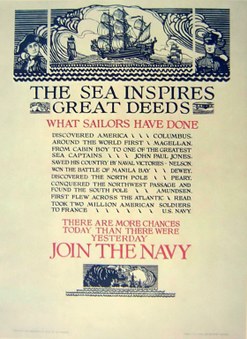
29
THE SEA INSPIRES GREAT DEEDS
WHAT SAILORS HAVE DONE
Discovered America, Columbus ~ Around the World First, Magellan ~ From Cabin Boy to One of the Greatest Sea Captains, John Paul Jones ~ Saved His Country by Naval Victories, Nelson ~ Won the Battle of Manila Bay, Dewey ~ Discovered the North Pole, Peary ~ Conquered the Northwest Passage and Discovered the South Pole, Amundsen ~ First Flew Across the Atlantic, Read ~ Took Two Million American Soldiers to France, U.S. Navy.
THERE ARE MORE CHANCES TODAY THAN THERE WERE YESTERDAY
JOIN THE NAVY
DESIGNED AND ENGRAVED ON WOOD BY J.J.A. MURPHY, Press U.S. Navy Recruitment Bureau
| 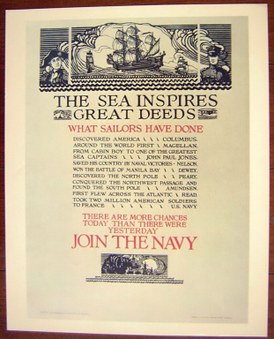
30
| 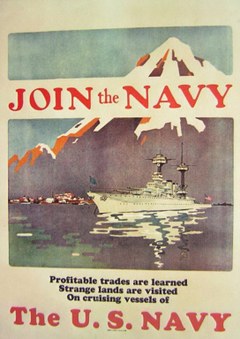
31
JOIN the NAVY
Profitable trades are learned
Strange lands are visited
On cruising vessels of
THE U.S. NAVY
| 
32
| 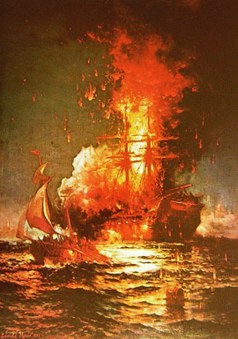
33
"THE MOST BOLD AND DARING ACT OF THE AGE"
Burning of the Frigate Philadelphia - 16 February 1804
During the Barbary wars, to deny the Tripolitan Corsairs the use of PHILADELPHIA which had run aground on an uncharted reef in Tripoli Harbor, Stephen Decatur and a crew of 84 volunteers in the ketch INTREPID succeeded in boarding and firing the ship after a furious hand-to-hand struggle while under fire from coastal batteries. British Admiral Lord Nelson, then operating in the Mediterranean during Napoleonic world wars admiringly called this, "The most bold and daring act of the age."
OIL BY EDWARD MORAN, U.S. Naval Academy Museum
| 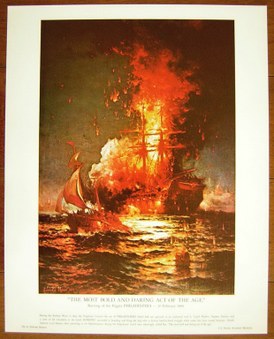
34
| 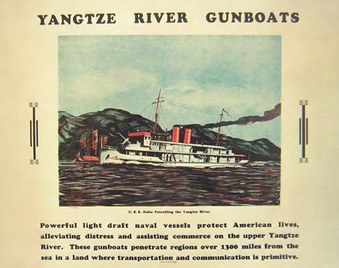
35
YANGTZE RIVER GUNBOATS
U.S.S. Oahu Patrolling the Yangtze River
Powerful light draft vessels protect American lives, alleviating distress and assisting commerce on the upper Yangtze River. These gunboats penetrate regions over 1300 miles from the sea in a land where transportation and communication is primitive.
| 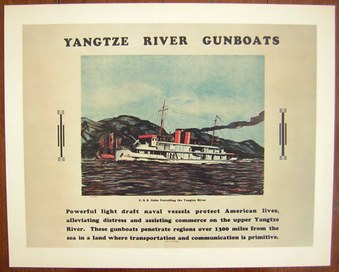
36
| 
37
"...WHATEVER EFFORTS ARE MADE BY THE LAND ARMIES, THE NAVY MUST HAVE THE CASTING VOTE IN THE PRESENT CONTEST." General George Washington
Battle Off the Virginia Capes, 5 September 1781
The local application of sea power by the French resulted in the surrender of the British army at Yorktown, thus setting America on the final course to success in the Revolutionary War. Prior knowledge of Admiral DeGrasse's sailing for the Chesapeake and the hopes of victory led to General Washington's decision to head south with his troops and those of General Rochambeau. The subsequent Battle off the Virginia Capes established control of the sea-approaches to Yorktown. After the fleets had maneuvered away from the Capes, Admiral de Barras entered to deliver siege cannon to the Americans. With some of his ships badly hulled, British Admiral Graves retired to New York. The forces of Washington and Rochambeau were transported by water from the head of th...
| 
38
| 
39
"THE PRESENCE OF A REPECTABLE FORCE IN THESE SEAS IS AT THIS TIME MORE NECESSARY THAN EVER FOR THE PROTECTION OF COMMERCE." Commodore John Rodgers
The U.S. Mediterranean Squadron Departing Port Mahon, Minorca, 20 January 1825
In the Barbary Wars at the turn of the nineteenth century, the fledgling Navy won respect for the United States and gained guarantees against depredations on commerce of the new nation. Nevertheless, continuing naval presence was required in the Mediterranean to ensure protection of numerous merchant ships against incipit piracy. Following the 1816 settlement with Algiers, a squadron was maintained in the area. Beginning in 1824, these ships were reinforced because of the British-Algerian war and piracy in the Grecian Archipelago incident to the Greek revolt against Turkey. Early in 1815, Commodore John Rodgers went out in the new ship-of-the-line NORTH CAROLINA, not only to protect American interests but also to initiate nego...
| 
40
| 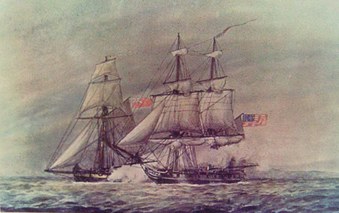
41
WATER COLOR IN THE BAILEY COLLECTION, The Mariners Museum, Newport News
Lexington Captures Edward
7 April 1776
Off the Virginia Capes, the Continental Brig Lexington, Captain John Barry, fell in with and captured HMS Sloop Edward after a hot and close action. "She engaged us near two glasses," Captain Barry reported to the Maritime Committee. "They killed two of our men and wounded two more. We shattered her in a terrible manner, as you will see... I have the pleasure to acquaint you that all our people behaved with much courage." An American prize crew delivered Edward safely to Philadelphia.
Naval Historical Division, Department of the Navy, Washington D.C.
| 
42
| 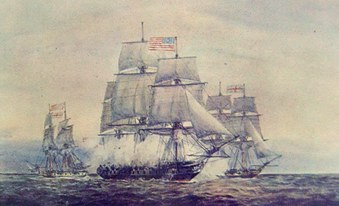
43
WATER COLOR IN THE BAILEY COLLECTION, The Mariners Museum, Newport News
Alliance Captures Atlanta and Trepassy
29 May 1781
The Continental frigate Alliance (Captain John Barry) returning from France fell in with HMS Atlanta and HM Brig Trepassy. Small puffs of air gave way to dead calm. The lighter British vessels manned sweeps to maneuver athwart the stern and quarters of Alliance, "laying like a dog" in the water. From this position, which nullified the American frigate's superiority in gun power, the enemy raked Alliance with round and grape shot for more than three hours. Captain John Barry, wounded in the shoulder, courageously kept the deck until forced below by loss of blood. A sudden breeze filled Alliance's sails, she answered her helm, her broadsides roared, and the colors of Atlanta and Trepassy gave down in surrender.
Naval Historical Division, Department of the Navy, Washington D.C.
| 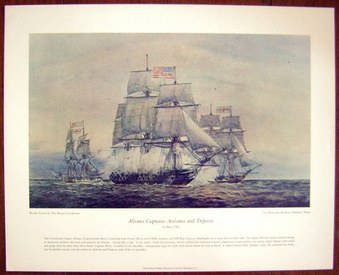
44
| 
45
Oil By Louis-Phillippe Crepin, U.S. Naval Academy Museum, Annapolis
Hyder Ally Captures General Monk
8 April 1782
Captain Joshua Barney in the privateer Hyder Ally, escorting merchant vessels outward bound from Delaware Bay, was chased by HM Sloop-of-War General Monk off Cape May. The merchantmen scattered for safety. Barney kept all gun ports secured, leading his more powerful foe to conclude that he would not stand and fight. When the distance closed to about 100 yards Barney ordered the helm hard aport, out came the guns and devastating raking fire swept the Britisher's deck. The ships crashed together, held fast, deadly rifle fire rained down from the tops and, in that manner they fought, "with the mussels of the guns almost rubbing together." The action was short but decisive, only 26 minutes from opening cannonade to General Mon's surrender. Of Barney's conduct, James Fennimore Cooper wrote: "Through-out the whole affair,...
| 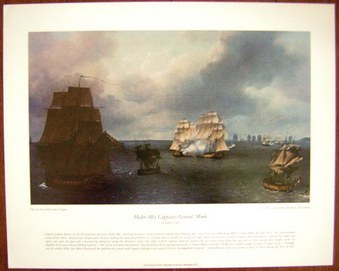
46
| 
47
WATER COLOR IN THE BAILEY COLLECTION, The Mariners Museum, Newport News
Capture of Mellish
12 November 1776
The Continental Naval vessels Alfred (Captain John Paul Jones) and Providence (Captain Hoysteed Hacker) captured Mellish off Cape Breton, Nova Scotia, after slight resistance. She was a 350 ton armed transport en route London to Quebec carrying a large cargo of clothing for the British troops in Canada. "This Prize is I believe," reported Jones, "the most valuable ship that hath been taken by the American Arms," and her capture "will make Burgoyne 'Sake a Cloth in the wind' and check his progress on the lakes." Washington's soldiers may have received some of the clothing off Mellish before the Battle of Trenton.
Naval Historical Division, Department of the Navy, Washington D.C.
| 
48
| 
49
OIL BY UNIDENTIFIED BRITISH NAVAL OFFICER, Historical Society of Pennsylvania, Philadelphia
Destruction of HMS Augusta in Delaware River
23 October 1777
Augusta, 64 gun ship-of-the-line, was part of a fleet which arrived in the Delaware to open supply lines for the British army occupying Philadelphia. Together with other ships, Augusta passed through a breach in the chevaux de frise obstructions on 22 October to bombard Fort Mufflin, while at the same time Hessian troops assaulted Fort Mercer on the opposite shore in New Jersey. The channel was narrow, and Augusta grounded on one of the many shifting sand bars. Daybreak of 23 October, Commodore John Hazelwood sighting the stricken enemy, closed to attack with row galleys and batteries of the Pennsylvania State navy. During the general engagement which followed, Augusta caught fie. The holocaust raged out of control. Flames reached her powder magazine about noon and Augusta blew up.
| 
50
| 
51
"...OUR SUPPORTING NAVAL FIRE GOT US IN... WITHOUT THAT GUNFORE WE POSSITIVELY COULD NOT HAVE CROSSED THE BEACHES." Colonel S.B. Mason, USA, Chief of Staff, 1st Division
The Battle for Fox Green Beach, Normandy, 6 June 1944
The largest amphibious operation the world has ever seen began early on this day. By mid-afternoon, disabled landing craft cluttered the few gaps in the beach obstacles. Support waves circled and jockeyed for an opening while under a steady rain of short and long range artillery fire. Since many amphibious craft carrying Army guns were destroyed, much of the fire power needed by the troops was lacking. The Navy's destroyers filled the breach. Because heavy casualties were suffered by the shore fire-control parties, the destroyers had to rely chiefly on their own visual observations and take under fire targets of opportunity. They ranged perilously close to shore in order to relieve the landing forces of the maze ...
| 
52
| 
53
"THE BEST PROTECTION AGAINST THE ENEMY'S FIRE IS A WELL DIRECTED FIRE FROM OUR OWN GUNS." Admiral David G. Farragut
Battle of Port Hudson, 14 March 1863
Port Hudson, just north of Baton Rouge n the Mississippi, protected the southern water approaches to the Red River, the Confederacy's crucial line of east-west communications to Texas. Farragut made the bold decision to force his way, under cover of darkness, upstream past the heavy Confederate batteries. HARTFORD, RICHMOND, AND MONONGAHELA, each with a gunboat lashed to its side, and the vulnerable sidewheeler MISSISSIPPI. headed north at 10 P.M. Under fire by the enemy batteries, RICHMOND suffered a severe steam line. MONONGAHELA and her consort temporarily grounded; MISSISSIPPI nosed hard aground and was destroyed. Only the flagship HARTFORD with gunboat ALBATROSS succeeded in running past the batteries. For nearly a month, Farragut patrolled the "no-man's lan...
| 
54
| 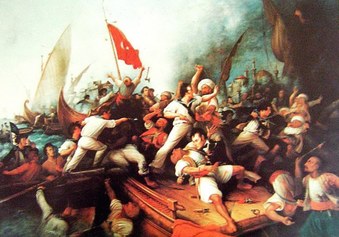
55
"THE AMERICAN IN BATTLE ARE FIERCER THAN LION, AND AFTER VICTORY, KINDER THA MUSSULMEN." Repatriated Wounded Tripolitans
Decatur Boarding a Tripolitan Gunboat - 1 August 1804
Diplomacy and ransom payments failed. Only United States naval strength in the Mediterranean called a halt to outrages against American citizens and commerce by the pirates of the Barbary States. Commodore Edward Preble led his squadrons against the forts and gunboats in Tripoli harbor. Fearlessly, captain Stephen Decatur, Jr., with his division of three gunboats plunged into the midst of nine enemy boats. "pistol, saber and tomahawk were made good use of by out brace tars" - one prize was taken and then a second, after a "severe and bloody conflict," Decatur wrote, "I am glad the event has proved my ideas [to board] to be correct." By reputation invincible in hand to hand combat, the Barbary Corsairs had more than met their match.
OIL BY D. M. CARTER, The Naval Historical Foundation
| 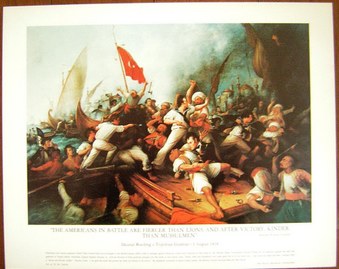
56
| 
57
A-6A INTRUDER ATTACK AIRCRAFT
| 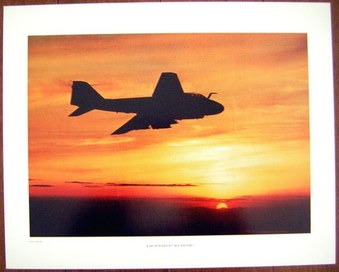
58
| 
59
E-2A HAWEYE AND E-1B TRACER AIRBORNE EARLY WARNING AIRCRAFT
| 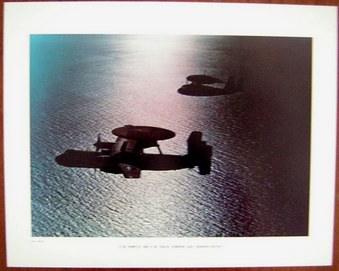
60
| 
61
"DAMN THE TORPEDOES, FULL SPEED AHEAD."
Battle of Mobile Bay - 5 August 1864
Exchanging shot at point-blank range with the Confederate flagship, CSS TENNESSEE, is Admiral David G. Farragut shown in the rigging of his flagship, USSS HARTFORD. After repeated rammings and incessant pounding by Union guns, her rudder chains and smoke stack shot away, many of her gun ports smashed, the ship filling with water and smoke, Admiral Buchanan wounded, TENNESSEE surrendered. Denying the use of the port facilities of Mobile to the Confederacy, one of the last large ports open to Confederate blockade runners, was of immense value to the Union forces.
OIL BY WILLIAM H. OVEREND, Wadsworth Atheneum
("An August Morning with Farragut" printed by permission of the Wadsworth Atheneum.)
| 
62
| 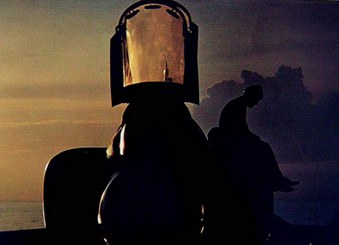
63
"DAYS END" - CREWMAN ON F-4B PHANTOM II FIGHTER AIRCRAFT
| 
64
| 
65
"THE UNITED STATES NAVY IS THE SUREST GUARANTOR OF PEACE WHICH THIS COUNTRY POSSESSES." Presiden Theodore Roosevelt
The Great White Fleet Passing through the Straits of Magellan - Cruise Around the World 1907-1909
In December 1907, a force of 16 battleships sailed Hampton Roads for a good will cruise around the world at the direction of broad visioned President Theodore Roosevelt. Calling at South American ports, the fleet sailed throigh the Straits, visited west coast cities and then steamed to Honolulu, New Zealand, Australia, Manila, and Japan. Everywhere they went, the American were greeted with cordiality and celebration. The visit to Japan was instrumental in restoring ambicable relations between the two countries. After visiting China, the Great White Fleet triumphantly returned to Hampton Roads in February 1909 via the Indian Ocean, Suez Canal and Mediterranean. Roosevelt's strategy for peace has been successful.
OIL BY H. REUTERDAHL, U.S. Naval Academy Museum
| 
66
| 
67
"NOBODY CAN ACTUALLY DUPLICATE THE STRAIN THAT A COMMANDER IS UNDER IN MAKING A DECISION DURING COMBAT." Admiral A. A. Burke
"The Little Beavers" - Destroyer Squadron 23 - November 1943
Led by Admiral Arleigh A. ("31-knot") Burke, DESRON 23 was part of Rear Admiral A. S. Merrill's Task Force 39 during the Battle of Empress Augusta Bay, November 1943, when four of the squadron's destroyers helped sink a Japanese cruiser and two destroyers. Ordered by Admiral "Bull" Halsey to scout the Buka-Rabaul evacuation route, on 25 November 1943, during the Battle of Cape St. George, The Little Beavers sank two new 2000 ton Japanese destroyers with their torpedoes and, after an hour long chase, a high speed transport by gunfire.
OIL BY ANTON OTTO FISCHER, Admiral Arleigh A. Burke
| 
68
| 
69
"WE ARE SAFELY ON THE OTHER SIDE OF THE POND." Lieutenant Commander A. C. Read
The First Transatlantic Flight - NC-4 - May 1919
Long range flying boats NC-1, NC-3, and NC-4 took off from the Naval Air Station, Rockaway, New York, 8 May 1919, on the first leg of this historic flight. A line of destroyers stretched along the route serving as communication links and rescue ships. After touching down at Trepassy, Newfoundland, and Halifax, Nova Scotia, they departed 16 May for Horta in the Azores. NC-4 reached Horta the following day. NC-1 and NC-3 landed in high seas which prevented their taking off. NC-1's crew was picked up by the Greek steamer IONIA while NC-3 literally "sailed" into Port Delgada on 19 May. After being delayed by weather, NC-4, Lieutenant Commander Albert C. Read commanding, reached Lisbon on 27 May completing the first transatlantic flight.
OIL BY C. E. RUTAN, U.S. Naval Academy Museum
| 
70
| 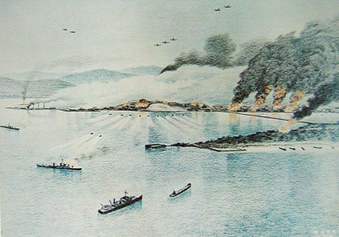
71
"THE NAVY AND MARINES HAVE NEVER SHONE MORE BRIGHTLY THAN THIS MORNING." General of the Army Douglas MacArthur
Landing at Inchon, Korea - 15 September 1950
Early in the Korean War, when the outnumbered American had their backs to the sea, General of the Army Douglas MacArthur employed an amphibious attack with its inherent mobility, concentration of firepower and surprise as a counter stroke against the Inchon-Seoul area. Two days of heavy shore bombardment an aerial bombing preceded the signal. :Land the Landing Force" at 0540. Thirty minutes later, the U.S. Marines controlled half of Walmi Do, The Inchon harbor island. That afternoon, 500 landing craft hit the Inchon beaches. By midnight the landing force has swept inland. The Communist armies in the South collapsed. A victory of great strategic importance was achieved by utilizing the advantages of the naval strength afloat.
PRISMACOLOR BY H. C. HAHN, U.S. Navy Combat Art Collection
| 
72
| 
73
Lee CAPTURES Nancy
29 November 1775
Captain John Manley in the schooner Lee of "Washington's Navy" carried an invaluable prize into Cape Ann, Massachusetts. The prize was the fully-loaded British ordnance brig Nancy captured en route to Boston with a cargo which included thousands of muskets, gunpowder, cannon, shot, and a huge 13" brass mortar. It has been estimated that the quantity of munitions seized in this one ship would have taken the colonists 18 months to manufacture. News of Nancy's loss shocked the British authorities. Lord Sandwich called it "a fatal event."
Naval History Division, Department of the navy, Washington D.C.
| 
74
| 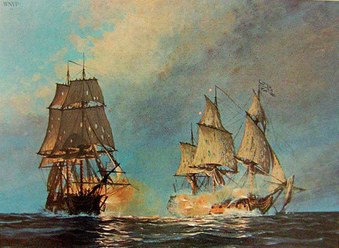
75
OIL BY NOLAND VAN POWELL, U.S. Naval Academy Museum, Annapolis
Ranger Captures Drake
24 April 1778
A daring raid into the confined waters of the Irish Sea by Captain John Paul Jones with the Continental sloop-of-war Ranger was capped by the memorable engagement with HMS Drake. The ships were evenly matched, and the action was "warm, close, and obstinate" for one hour. When the shattered enemy "called for Quarters," Jones described the scene on board Drake - "her Fore and Main Topsail Yards being both Cut away and down on the Cap. The Top Gallant Yard and Mizzen Gaffe both hanging up and down along the Mast. The 2nd Ensign which they had hoisted shot away and hanging over the Quarter Gallery in the Water. The Jibb shot away and hanging in the Water, her Sails and Rigging entirely cut to pieces her Masts and yards all wounded and her Hull very much Galled."
Naval History Division, Department of the navy, Washington D.C.
| 
76
| 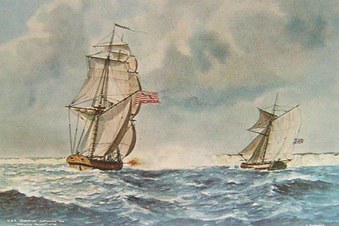
77
WATER COLOR BY E. TUFNELL, Curator for the Department of the Navy, Washington D.C
Surprize Captures the Harwich Packet
3 May 1777
The lugger Surprize (Captain Gustavus Conyngham) was purchased at Dunkirk, France, and outfitted as a Continental cruiser. Under the guise of a smuggler she sailed on 1 May. Two days later in the English Channel, Conyngham seized Prince of Orange, a packet carrying mail between Harwich, England, and Holland. Conyngham immediately returned to Dunkirk and dispatched the captured mail to the American Commissioners in Paris. Raids in British home waters by American naval captains brought the war close to the enemy and generated grave alarm among merchants. Silas Deane noted: "For the first time since Britain was a maritime power, the River Thames and other of its ports were crowded with French and other ships taking in freight, in order to avoid the risk of having British property captured."
Naval Historical ...
| 
78
|
|